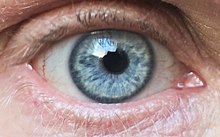Limbal ring


A limbal ring is a dark ring around the iris of the eye, where the sclera meets the cornea.[1] It is a dark-colored manifestation of the corneal limbus resulting from optical properties of the region.[2] The appearance and visibility of the limbal ring can be negatively affected by a variety of medical conditions concerning the peripheral cornea.[3] It has been suggested that limbal ring thickness may correlate with health or youthfulness and may contribute to facial attractiveness.[3][4] The thickness of the limbal ring varies by pupil dilation - when the pupil is larger, the limbal ring narrows.[5] Some contact lenses are colored to simulate limbal rings.[1]
Youth, health, and attractiveness

Both health and age are positively correlated with a prominent limbal ring.[6] For instance, a darker limbal ring tends to be found more attractive than the absence of a limbal ring, suggesting that both sexes "use the limbal ring as a probabilistic indicator of reproductive fitness".[6] Furthermore, limbal rings appear to be most noticeable "for individuals relatively free from chronic health issues".[7]
The limbal ring is thought to contain corneal epithelium stem cells.[8] Diseases involving a limbal stem cell deficiency are associated with blindness, as those with such deficiencies are "unable to maintain a stable corneal surface."[9] Transplantation of limbal stem cells is a promising therapy for limbal stem cell deficiency.[10]
See also
References
- ^ a b Johnson and Johnson Vision Care Inc. Tinted contact lenses with combined limbal ring and iris patterns. US7246903B2. United States Patent and Trademark Office, July 24, 2007.
- S2CID 39174174.
- ^ PMID 22947961.
- PMID 28978250.
- ISSN 1040-5488.
- ^ PMID 22947961.
- PMID 28978250.
- PMID 15781286.
- S2CID 21296292.
- PMID 30861002.
External links
 Media related to Limbal rings at Wikimedia Commons
Media related to Limbal rings at Wikimedia Commons
